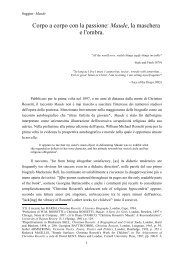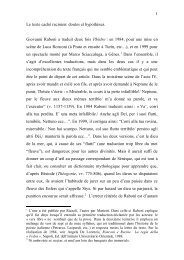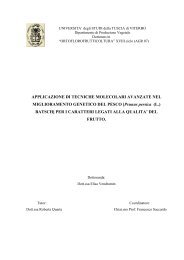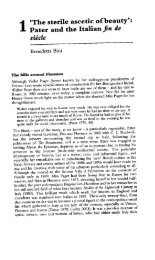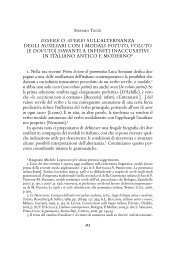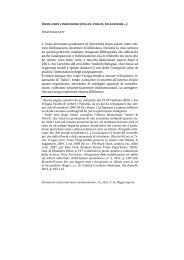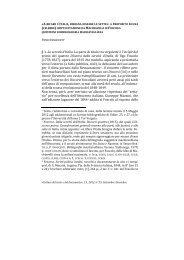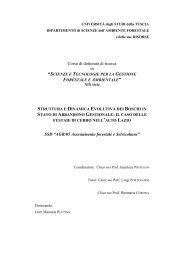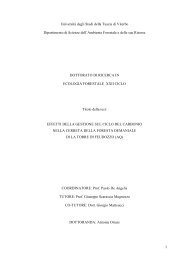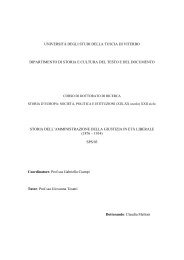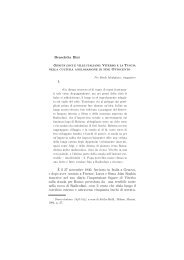drivers of soil respiration of root and microbial ... - Unitus DSpace
drivers of soil respiration of root and microbial ... - Unitus DSpace
drivers of soil respiration of root and microbial ... - Unitus DSpace
Create successful ePaper yourself
Turn your PDF publications into a flip-book with our unique Google optimized e-Paper software.
1.1. Global C balance: biosphere-atmosphere interactions <strong>and</strong> human influence.<br />
12<br />
The earth contains approximately 10 8 Gt <strong>of</strong> C distributed in several pools which differ in<br />
their size <strong>and</strong> turnover times (Fig.1).<br />
Fig. 1 The global carbon cycle. Values are given in Gt C. Bold prints represent reservoirs <strong>and</strong> normal prints<br />
represent fluxes. Mean residence time <strong>of</strong> the pools is given in parentheses. DOC = dissolved organic carbon,<br />
DIC = dissolved inorganic carbon. Source: WBGU (Schubert et al. 2006). Adapted after Schlesinger (1997);<br />
WGBU (2003). Numbers exp<strong>and</strong>ed <strong>and</strong> updated for ocean <strong>and</strong> fossil fuels: Sabine et al. (2003); Raven et al.<br />
(2005); for atmosphere: NOAA-ESRL, (2006).<br />
Natural systems <strong>and</strong> biogeochemical cycles have historically maintained these pools in dynamic<br />
equilibrium. More recently, anthropogenic activities such as deforestation, agricultural practices, <strong>and</strong> the<br />
burning <strong>of</strong> fossil fuels have resulted in large shifts among carbon pools, particularly since the beginning <strong>of</strong><br />
the industrial revolution (IPCC 1995, 2001) (Fig.2). Annual emissions <strong>of</strong> CO2 from fossil fuel<br />
combustion are small relative to the natural flows <strong>of</strong> carbon; nevertheless, these anthropogenic<br />
emissions are the major contributor to increasing concentrations <strong>of</strong> CO2 in the atmosphere <strong>and</strong><br />
above all they represent a transfer <strong>of</strong> carbon from the slow carbon cycle to the active carbon cycle.<br />
From 1850 to 1998, 270 ± 30 Gt C were emitted from fossil fuel burning <strong>and</strong> cement production<br />
(Marl<strong>and</strong> et al., 1999). During the same period, emissions from l<strong>and</strong> use change were estimated at<br />
136 ± 55 Gt C (Houghton 2003). These last were related to deforestation, biomass burning,<br />
conversion <strong>of</strong> natural to agricultural systems <strong>and</strong> the ploughing <strong>of</strong> <strong>soil</strong>s. World <strong>soil</strong>s historically<br />
have been major source <strong>of</strong> atmospheric enrichment <strong>of</strong> CO2: until the 1950s more C was emitted into<br />
the atmosphere from l<strong>and</strong> use change <strong>and</strong> <strong>soil</strong> cultivation than from fossil fuel combustion (Lal,<br />
2003). Presently, about 20% <strong>of</strong> the global emissions come from l<strong>and</strong> use change (IPCC, 2001). In<br />
fact, <strong>soil</strong>s with a total global storage <strong>of</strong> approximately 1500 Gt C (Jacobson et al. 2000) hold three




